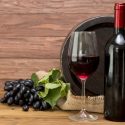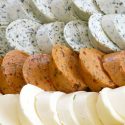What Is Natamycin (E235) In Food? Uses, Safety, Side Effects

Production | Inhibition | Uses | Safety | Side effects | Conclusion
Natamycin, also known as pimaricin, is a fungicide of the polyene macrolide group, commonly used as a biopreservative in the surface treatment of cheeses and sausages to inhibit yeasts and moulds. It also can be used in yogurt, baked goods, beverages and wines. The European food additive number for it is E235.
It is available in four types in the market, pure natamycin, 50% natamycin preparations with excipients of lactose, glucose or salt.
How is it made?
Natamycin is a natural antimycotic ingredient produced by controlled fermentation of Streptomyces natalensis (commonly found in soil) and other relevant species and then through the manufacturing process of extraction, crystallization and drying process.
How does it work?
Natamycin inhibits the growth of yeast and mold, also prevents the production of their toxins, but has no effect on bacteria as their membrane lacks sterols. Its mechanism of action is binding to sterols (principally ergosterol) in the fungal cell membrane instead of permeabilizing the membrane (1), which is the functional mechanism of chemical synthesized preservatives – sorbates and benzoates.
Specification
Other Names
Pimaricin
CAS Number
7681-93-8
Chemical Formula
C33H47O13N
Molecular Weight
665.74
Structure

Image source
Properties
- Tasteless, odorless and will not affect food appearance, taste and colour
- A broad-spectrum antimycotic activity
- Effective at low doses (1 – 10 ppm)
- Active in a wide pH range (pH 3 – 9): making it suitable for acidic, neutral and alkaline foods
Appearance
White to creamy-white crystalline powder.
Solubility
Practically insoluble in water lipid and mineral oils; slightly soluble in methanol.
What are the uses?
Natamycin can effectively inhibit the growth and reproduction of various molds and yeasts, but no inhibitory effect on bacteria. It is commonly used to kill yeast and mold on the surface of the natural fermentation products, such as yogurt, cheese, ham, and dry sausage and therefore extend the shelf life. It is used as an antifungal infection of eyes in pharmaceuticals.
How to use it?
Cheese
Spray natamycin aqueous solution on the surface of the cheese to prevent cheese mildew and extend the shelf life. It is also workable by soaking cheese in the solution.
Dried meat
Soak the sausage with a concentration of 300mg/L natamycin aqueous solution to prevent casing stickiness and mildew.
Others
It can prevent spoilage and extend the shelf life of juices of fruit & vegetable, and wine by adding 5-10mg/kg natamycin. It can also be used in un-yeast fermented baked goods.
Natamycin VS Sorbates and Benzoates
The low solubility of natamycin is an advantage for the surface treatment of food as it will stay on the surface of the food where most molds and yeasts may grow thus preventing their growth.
In contrast, the artificial preservatives, potassium sorbate and sodium benzoate are water-soluble and can be penetrated into food, thus making its concentration at the surface going down and therefore mold will grow.
A news in 2014 reported that Kraft was replacing sorbic acid by the natural mold inhibitor – natamycin in wrapped cheese slices (2). Now the label of the cheese Kraft Singles American Cheese Slices is marked as no artificial flavors or preservatives and you’ll see natamycin in the ingredients list. (3)
Is natamycin safe?
Yes, its safety when used as a food additive has been approved by the U.S. Food and Drug Administration (FDA), Canada Health, European Food Safety Authority (EFSA), Joint FAO/WHO Expert Committee on Food Additives (JECFA), as well as other authorities.
FDA
It is permitted for direct addition to food for human consumption and may be used as an antimycotic on cheese in amounts not more than 20 mg/kg. (4)
By the way, FDA had no question on DSM’s conclusion that natamycin is Generally Recognized as Safe (GRAS) when used as an antimycotic to prevent the growth of molds and yeasts in ready-to-drink tea beverages, fruit-flavored beverages & energy drinks, and sport and isotonic drinks at levels not more than 0.5 mg/kg (5) AND in yogurt at levels not to exceed 5 ppm. (6)
Canada Health
It is permitted to used in preventing mould growth on the surfaces of cheeses with the maximum levels (7):
- (naming the variety) cheese and cheddar cheese: 20ppm
- Grated or shredded (naming the variety) cheese and grated or shredded cheddar cheese:10ppm
EFSA
Natamycin (E235) is listed in Commission Regulation (EU) No 231/2012 as an authorised food additive and categorized in “Additives other than colours and sweeteners” (8).
Evaluation in 2009
For the use of natamycin as a food additive, EFSA concluded that there was no safety concerns if only used in the surface treatment of the rind of semihard and semi-soft cheese and on the casings of certain sausages with the proposed use levels. Also, there was no concern for the induction of antimicrobial resistance. (9)
Authorised Uses And Use Levels
The following are the details for the uses and levels (10):
- only for the external treatment of uncut hard, semi-hard and semi-soft ripened cheese and cheese products: at a maximum level of 1 mg/dm2 surface, not present at a depth of 5 mm.
- only surface treatment of heat-treated (or not) dried cured sausages, at a maximum level of 1mg/kg.
UK Food Standards Agency
Categorized in “Preservatives” (11)
Food Standards Australia New Zealand
In Australia and New Zealand are all with the code number 235. (12)
JECFA
Functional Class: food additives, preservative. (13)
Acceptable daily intake: ADI “0.3 mg/kg bw” set in 1976. (14)
What are the possible side effects?
It is common that sometimes consumers have health concerns whether natamycin is bad for our health and what are the possible side effects. It is generally considered safe but may cause some allergy symptoms when used in pharmaceuticals, such as rash, hives, itching, red, swollen, blistered and so on. (15)
Is it safe during pregnancy?
Yes, it is generally safe but better consult your doctor in the condition of use.
Frequently asked questions
Is it natural?
Yes, it is a natural preservative obtained from the fermentation process.
Is it Halal?
Yes, it is generally recognised as halal as it is permitted under the Islamic Law and fulfill the conditions of Halal. And we can find some manufacturers certificated with MUI halal.
Is it Kosher?
Yes, it is kosher pareve. E235 meets all the “kashruth” requirements and can be certified as kosher.
Is it Vegan?
Yes, it is vegan friendly as the manufacturing process without the use of animal matter or products derived from animal origin. So it is suitable to add it in the diet of vegetarians.
Is it gluten free?
Yes, it complies with the FDA’s definition of gluten free, that it does not contain wheat, rye, barley, or crossbreeds of these grains. And it is generally considered safe for people with celiac disease.
Conclusion
Now I think you may have a good knowledge of preservative – natamycin (E235), from the production process, uses, approved safety and possible side effects. Also, you may be clear with some common FAQs such as is it gluten free and vegan.
What kinds of food packaging have you found this additive in? Let me know in the comments.



My son and I can not tolerate natamycin. In the middle of eating a meal, we experience nausea, diarrhea and vomiting. It’s been 8 years since I traced down the source of my son throwing up every other week (literally.) If we simply avoid this additive we are fine. Every time we risk eating cheese because we can not access an ingredient label we can tell mid-meal if it contains natamycin or not, as we start to get bloated and have to stop eating to reduce the severity of the side effects. My husband and daughters can eat cheese containing natamycin, but my husband says he can always smell the difference in pizza that has it, and pizza that doesn’t.
It is an ingredient in single wrapped miceli’s string cheese sticks along with part skim milk, cheese cultures, salt and enzymes. Natamycin is the last ingredient
Hi Heather,
Thanks for your information.
Hi Patty,
How did you realize it was the natamycin in cheese (instead of other ingredients) that made you such a bad experience?
This page really has all of the information and facts I wanted about this subject and didn’t know who to ask.
I have a bad reaction to it also. I can not eat any preservatives. My sister was visiting and Philadelphia Cream Cheese here, unopened. I ate some of it last night not looking at the label for included junk, my first mistake. Less than an hour later I was vomiting, diarrhea, bloating, and a horrible headache. I don’t know what induced me to eat that garbage without reading the label, I know I can’t eat that preservative. Will take me a few days to get back to normal. Threw the tub of Philadelphia Cream Cheese in the trash, won’t feed it to my dogs.
I don’t like the powdery texture of it on my tongue.
Hi,
I have found it triggers migraines- the kind with visual aura- very potent and I have to avoid it. It’s scary when I want to eat Italian or Mexican at a restaurant because I can’t read the cheese ingredient package to know if they’ve used it or not.
Hi.
How do I make a natamycin solution to immerse cheese? If it’s not water soluble how do I disolve it?
Hi,
Although it is practically insoluble in water, but this solubility is enough to formulate a solution. Hope it helps.
I am allergic to mycin antibiotics and if I eat something with natamycin in it I get swelling and gastrointestinal problems
I’m experiencing diarrhea as I’m typing this. Probably because Natamycin can be made from items I’m allergic to.( many grains can be considered gluten free, but if you have multiple grain allergies, this will cause a reaction.)I have extensive food allergies, therefore the Philly Cream Cheese spread is off the list of safe foods for me.
If you have mold allergies, Natamycin should be avoided.
After eating grated parmesan cheese with preservative (E235) which I now have discovered is Natamycin, I get severe migraine. It lays me flat, with nausea and burning eyes. Just a self reminder to always read the labels! Any food in a packet is a danger to me. Preservatives are real poison for me.
My mom believes that Natamycin causes her to go into AFIB. She has had it with cheese, breads, pizza and wine. She spends a ton of time trying to find out what it’s in it before she buys anything. Have you ever heard of this before?
Sorry,I haven’t
I was just given 12 lb of shredded cheddar that lists this. Of course that will last a long time, but I will eat more than usual. Do I need to be concerned about eating too much natamycin over a given time?
Just found this additive in Gouda Jalapeno cheese from ANCO fine cheese ( 35% M.F. 41% moisture) by ANCOCHEESES.CA
I’m also very sensitive to preservatives so will soon find out how this goes. Often read ingredients before buying any products. This time l read it after eating a few slices. And then started looking this one up, as l was not familiar with it.
Out of 6 diffrent makes and types of cheeses, in my fridge today, this was the only one containing Natamysin.
Hi can I use natamycin in biltong manufacturing and will it prevent the dried biltong from becoming mouldy?
I just noticed this ingredient in Trader Joe’s Quattro Formaggi grated cheese blend. I’ve used this cheese blend before and never noticed any problem, but I had never seen this ingredient before. Now I’m going to pay attention to any reactions as I know other artificial sweeteners and preservatives do cause problems for me. I hope it doesn’t because I love this cheese blend!
I’m allergic to erythromycin, vancomycin and neomycin, and know to avoid those. Starting getting itchy rashes after eating cheeses and breads that I had always been able to eat – discovered natamycin in all of them. I generally have to buy organic to avoid.
@ Carrie, I had never heard of natomycin until today. Bought a large bag to make lasagna, being lazy not wanting to shred my onw cheese. Two hours after eating I was having tachycardia. So yes, your mother is probably correct. I too am very sensative to additives, especially fresheners, BHA, BHT, TBHQ. Now I have a new one to add to the growing list.
After reading so many comments where people are having reactions to natamycin, I’m thinking its rare, but certainly affects a fair number of people. Natamycin still has GRAS status, so there must not be enough affected people to remove it from the GRAS list? I’m not sure how that works.
I am also here because I’ve developed an allergy to natamycin. Took me a while to figure out what it was – I can eat cheese without it with no problem, but any amount of natamycin that I eat makes my digestive tract feel terrible. Even seemingly trace amounts.
Unfortunately, in the US it is also used as a surface treatment on a wide variety of crops – including berries, nuts, “stone fruits” and much more… it is not included on the ingredient list, since it is just a surface treatment… I have found that a vegetable wash with alcohol is able to remove it. However, it is getting harder and harder to find foods that do not contain it!
Just wanted to add to the list of people who experience tachycardia. Ate two meals that had my heart acting crazy, read the ingredients to see what could be the culprit and the only thing I didn’t recognize was the natamycin in both. Guess I’ll have to watch out for this now too.
I recently started having unexplained nausea that lasts all day. I started eliminating foods one at a time to see if there was anything I’d been eating that might be causing it. It seems to be the Walmart finely grated “Fiesta” cheese. Natamycin is an ingredient. I used it in my scrambled eggs but will discontinue that practice. I’ve been feeling better since I stopped consuming it. Oddly, this hasn’t been an issue until about the past 2 months because I’ve been using pre-grated cheese for years without a problem.
I ate some Reser’s potato salad and on three different occasions of ingesting this potato salad I was having tachycardia. So I went to check out the ingredients and this Natamycin was the only ingredient I didn’t recognize nor know what it was, not sure what was causing my symptoms, but… I take meds for tachycardia so I was surprised when on the only time I had this happen I had eaten was the potato salad within 1 to 2 hours after eating it. The third time it was the only thing I ate and within 30 minutes I was starting to feel the racing heart rate and ended up having to take another pill as directed from my dr. I should take one if I ran into a full blown racing heart. I usually eat organic foods as I have issues with any milk that has the rBst in it. They claim it’s not any different than milk treated without it. But I get a bad reaction within an hour after ingesting that too. Not with my heart but other symptoms. It’s a long story! I wish they’d leave our food alone, all the extra additives!! I hate having to read every ingredient. It should not be this way!
I ate some Reser’s potato salad and on three different occasions of ingesting this potato salad I was having tachycardia. So I went to check out the ingredients and this Natamycin was the only ingredient I didn’t recognize nor know what it was, not sure what was causing my symptoms, but… I take meds for tachycardia so I was surprised when on the only time I had this happen I had eaten was the potato salad within 1 to 2 hours after eating it. The third time it was the only thing I ate and within 30 minutes I was starting to feel the racing heart rate and ended up having to take another pill as directed from my dr. I should take one if I ran into a full blown racing heart. I usually eat organic foods as I have issues with any milk that has the rBst in it. They claim it’s not any different than milk treated without it. But I get a bad reaction within an hour after ingesting that too. Not with my heart but other symptoms. It’s a long story! I wish they’d leave our food alone, all the extra additives!! I hate having to read every ingredient. It should not be this way!
I just discovered that natamycin is a migraine trigger for me. I’d recently started eating dairy again and am trying things out. I had been eating a cream cheese that was all natural and organic and I did fine. I shopped at a different store that didn’t have that brand so I bought Philadelphia Cream Cheese and it took a couple of days of eating it before I started getting daily migraines and then I figured it out.
To Carrie, who’s mom reportedly gets AFIB from eating cheese, breads, wine, and pizza… If she gets it from eating breads that are fermented like sour dough, rye, or pumpernickel for example, then it is probably from the tyramine in those foods. She should google tyramine sensitivity. (I’m assuming “AFIB” is an exaggeration and your mom is actually getting palpitations or increased heart rate (tachycardia))
Ironically, I specifically bought cream cheese (instead of other aged cheeses) because it is low in tyramine which is a migraine trigger.
Just wanted to confirm Amie D. comment.
Resers Potatoe Salad DOES contain the additive, Natamycin, and it states so on the ingredient label.
Part of a healthy microbiome are fungi. Does this have a negative affect on them?
Hello
To add to your data base and as per your request, I was looking at the ingredients on a box of samosas that I bought that lists Natamycin as an ingredient.
The samosas are made by Brar’s of Mississauga, Ontario.
A little late here but AALL Walmart Great Value shredded cheeses has Natamycin as mold retardant and Kroger’s Private Label and Kroger Brand grated Parmesan/Asagio/Romano and Parmesan cheeses have Natamycin.
Do people know that this is also a prescription drug for eye conditions?
Most packaged meals from Factor contain natamycin.
I just saw natamycin listed on a pound bag of Cotija Mexican style grated cheese. It is very finely grated cheese that also has potassium sorbate and sodium citrate and glacial acetic acid. I’ve eaten it twice and I don’t recall any adverse effects from it. However, if it is only to be on the rind of uncut cheese, this isn’t following the rules.
Beth, I am here because I have gotten extremely nauseous after eating 2 factor meals and noticed they both had this ingredient. It is the only thing in the meals that I think would make me sick. In addition to it making me nauseous, it has also triggered a migraine both times I have had it. I have now read in the comments, that both of these things have happened to other people who ingested natamycin. I am certain this is the cause. I am usually sick for at least 24 to 48 hours after eating it, and I won’t be eating any more meals from Factor. I plan to contact them as well.
I get anaphylactic shock from myosin- hospitalized 2 times . so I have been lucky to only have gotten headaches and other issues like slightly sore throat but I will no longer be eating shredded cheese. I’m hoping my symptoms will subside. A farmer’s market I go to sells cheese. I will get block cheese from there from now on.